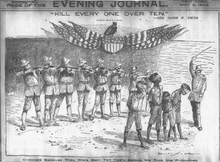Our website is made possible by displaying online advertisements to our visitors.
Please consider supporting us by disabling your ad blocker.
Pacification of Samar
| Pacification of Samar | |
|---|---|
| Part of the post-war insurgency phase of the Philippine–American War | |
 Editorial cartoon depicting atrocities carried out by U.S. Marines during the Samar campaign | |
| Location | |
| Planned by | General Jacob H. Smith |
| Commanded by | General Adna Chaffee |
| Objective | Neutralize rogue guerilla force following conclusion of general hostilities |
| Date | December 8, 1901– February 22, 1902 |
| Executed by | U.S. Army, U.S. Marines |
| Outcome | Objective achieved but with significant collateral damage and noncombatant casualties |
| Casualties | Most estimates range from between 2,000 and 2,500 victims; 5,000 according to other sources. Some estimates are as high as 50,000, albeit these are supported by population figures now known to be a result of typographical errors and the misreading of documents.[1] |
The Pacification of Samar was a counterinsurgency operation initiated by General Adna Chaffee following the Balangiga massacre. General hostilities in the Philippine-American War had largely ceased following the capture of Emilio Aguinaldo, president of the insurgent Philippine Republic, and his publication of a manifesto on April 10, 1901 acknowledging and accepting U.S. sovereignty throughout the Philippines.[2]
General Vicente Lukban had been the commander, under Aguinaldo, of a guerilla force on the island of Samar and had, when offered the opportunity to surrender, replied that he intended to fight on to the end.[3] In September, in an action that became known as the Balangiga massacre, Lukban's forces assisted by townspeople in a surprise uprising inflicted 54 killed and 18 wounded on a U.S. Army company garrisoning that town.[4] Following this, General Jacob H. Smith was tasked with the pacification of Samar.[5]
During the pacification, Smith ordered an indiscriminate retaliation which involved stopping the flow of food and causing extensive destruction in order to make the people of Samar abandon their support for the rebels out of fear and malnutrition and turn to the Americans instead.[6] He also infamously ordered to "kill everyone over the age of ten [and make the island] a howling wilderness."[7][8] Despite Smith's subordinate Littleton Waller partly revoked his order,[9] American soldiers eventually killed between 2,000 and 2,500 civilians;[9] some historians put the number as high as 5,000 victims.[10] Some sources place the death toll as high as 50,000,[11][12] but these are now believed to have resulted from typographical errors and misreading of documents.[13] Smith was court-martialed for his conduct of operations on Samar. Waller was also later tried for ordering or allowing the execution of a dozen Filipino porters.[8]

- ^ Bartrop, P.R.; Jacobs, S.L. (2014). Modern Genocide: The Definitive Resource and Document Collection [4 volumes]: The Definitive Resource and Document Collection. ABC-CLIO. p. 1983. ISBN 978-1-61069-364-6.
[I]t is now known that the oft-quoted figure of 50,000 was based on typographical errors and misreading of documents.
- ^ "Today in Filipino History, April 19, 1901, Aguinaldo issued Peace Manifesto after his capture and after his Oath of Allegiance to the United States". Office of the Military Governor in the Philippine Islands. n.d. [April 19, 1901]. Retrieved September 19, 2024.
- ^ Miller 1982, p. 199.
- ^ Multiple sources, including:
- Taylor, James O. (1931). The Massacre of Balangiga: Being an Authentic Account by Several of the Few Survivors. McCarn Printing Company.
- Borrinaga, Rolando O. (2003). The Balangiga Conflict Revisited. New Day Publishers. pp. 114, 194, 197. ISBN 978-971-10-1090-4.
- Linn, Brian McAllister (2000), "Samar", The Philippine War, 1899–1902, University Press of Kansas, pp. 306–321, doi:10.2307/j.ctvgs0c6m, ISBN 9780700612253, JSTOR j.ctvgs0c6m – via Jstor
- ^ Feight, Andrew (n.d.). "General Jacob H. Smith & the Philippine War's Samar Campaign". sciotohistorical.org. Retrieved September 19, 2024.
- ^ "Jacob F. Smith."(2010). Encyclopædia Britannica Online. Retrieved 2010-09-30.
- ^ Miller 1982, p. 220
- ^ a b PBS documentary "Crucible of Empire"; Ten days after President William McKinley's death, the residents of Balangiga, a tiny village 400 miles southeast of Manila, attacked the local U.S. garrison. While U.S. soldiers ate breakfast, the church bells rang a signal. Filipinos brandishing machetes emerged from their hiding places. Forty-eight Americans, two-thirds of the garrison, were butchered, in what is called the Balangiga massacre. On the orders of General Jacob H. Smith, U.S. troops retaliated against the entire island of Samar where Balangiga is located. The exchange is known because of two courts-martial: one of Waller, who was later court-martialed for ordering or allowing the execution of a dozen Filipino bearers, and the other of Gen. Jacob H. Smith, who was actually court-martialed for giving that order. The jury is out to the extent that order was carried out, because Littleton Waller actually countermanded it to his own men and said "Captain David Porter, I've had instructions to kill everyone over ten years old. But we are not making war on women and children, only on men capable of bearing arms. Keep that in mind no matter what other orders you receive." Undoubtedly, some men did commit atrocities regardless of Waller's commands.
- ^ a b Miller 1982, p. 220.
- ^ Fritz 1979, p. 186
- ^ Duka, C.D. (2008). Struggle for Freedom' 2008 Ed. Rex Book Store. p. 198. ISBN 978-971-23-5045-0.
- ^ Gaido, D. (2006). The Formative Period of American Capitalism: A Materialist Interpretation. Routledge International Studies in Business History. Taylor & Francis. p. 147. ISBN 978-1-134-22200-1.
- ^ Bartrop, P.R.; Jacobs, S.L. (2014). Modern Genocide: The Definitive Resource and Document Collection [4 volumes]: The Definitive Resource and Document Collection. ABC-CLIO. p. 1983. ISBN 978-1-61069-364-6.
Previous Page Next Page


